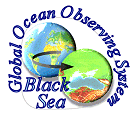Russian Federation
Despite the economical difficulties, the Russian hydrometeorological and oceanographic activities (including monitoring of contaminants and living resources) in the Black Sea continue. Several national agencies are involved in these activities, including
Rushydromet, the Russian Academy of Sciences, Russian Committee for Fisheries
and the Defence Ministry. Recently, federal support for these activities has somewhat increased which is attributed to the commencement of
a Target Federal Programme “The World Ocean”. This programme includes, in particular, the
sub-programmes “ Development of an integrated informational system on the state of the World Ocean
(ISWO)” and “Studies of the World Ocean nature”. The objectives and tasks of ISWO are very similar to these of
the GOOS. In particular, the ISWO aims at providing support to decision-making in the sea-related activities including those unfolding in the Black Sea. The
sub-programme “Studies of the World Ocean nature” allocates funds for the research ship cruises in the Black Sea which provides an informational basis for
the improvement of analysis and forecasting technologies.
Coastal observational facilities include:
- 5 hydrometeorological stations (4-time-a-day observations of standard meteorological parameters, sea level, water temperature,
waves and salinity)
- a waverider buoy stationed off the coast of Gelengik operating continuously since 1996; the buoy measures the wave parameters, including propagation direction and temperature and transmits the data to the coastal reception station every 3 hours (or every hour if the wave height exceeds 1.5 m/s); the buoy is insensitive to sea currents of a speed less than 2.5 m/s
- automated systems for measuring meteorological parameters, sea level, water temperature, waves in the coastal area, current speed and direction, temperature at depths; measurements are made every 3 hours and transmitted to the collecting center via satellite channels. The systems are
still being tested.
Open Sea Observational Facilities
VOS meteorological observations are very sparse, with only 200-300 ship weather reports available every year.
Ship deep sea observations are performed at the standard sections only in the eastern part of the sea using R/V Aquanavt (of a 270-tonn water displacement). During November 1997 through
the April 2000, a total of 20 cruises, (each 3-7 days) long were accomplished. Spacing between stations is 2-3 miles on the shelf, 5 miles in the 20-mile coastal area and 10-15 miles in the sea's interior. The measurements are normally made down to 500
m, some sections in the sea's interior being sampled to the bottom (about 2000 m).
Drifting buoys allow determination of water mass trajectories, air temperature and pressure in the entire Black Sea and transmit it to a collecting center via satellite channels. Tests performed in 1999 – 2000 in co-operation with the Ukrainian scientists yielded promising results.
Satellite observations involve Okean01, Sich, Meteor-3 and Resurs-01 satellites.
Surface temperature, ocean color, and ice coverage, are remotely measured.
Sea climate and climate change
The information on climate and climate change is being prepared in the electronic form by the State Oceanographic Institute based on earlier hard-copy monographs,
published early in the 90's. It is planned that during 2001-2002 a regional center on the southern seas including the Black Sea will be established whose responsibility will be
the provision of various reference documents on the long-term state of the sea and its change.
The center will also run a hydrodynamic model of the Black Sea developed in the SOI,
assimilate various kinds of observations (sea-, coast- and space-borne) and compute mutually adjusted oceanographic fields.
Pollution monitoring
There are two scales of monitoring – local (near the sources of pollution) and background (in the open sea). The local monitoring is made at 24 stations at 5
different sites. The water is sampled for salinity, dissolved oxygen, total alkalinity, pH, hydrocarbons and some specific chemical spices.
Open sea monitoring is made during ship cruises. A complex structure of currents in the region makes monitoring a very complicated task.
Research activities
The R/V «Akvanavt» is of 270 tons displacement, there are 12 crew
and 10 scientific personnel. The ship is equipped with a winch for lowering oceanographic probes and devices to
a depth of 2500 m. It is based in Gelendzhik where the Southern Branch of the P.P.Shirshov Institute of Oceanology is located.
In the period from November 1997 till April 2000 20 expeditions aboard this ship were carried out within the Russian sector of the Black Sea, their durations being from 3 to 7 days. Oceanographic measurements were carried out along the cross-sections «shore - sea
centre», within the oceanographic polygon of the nearshore zone and during oceanographic surveys in
the 40-mile nearshore zone from the Kertch Strait to
Sochi.
|

